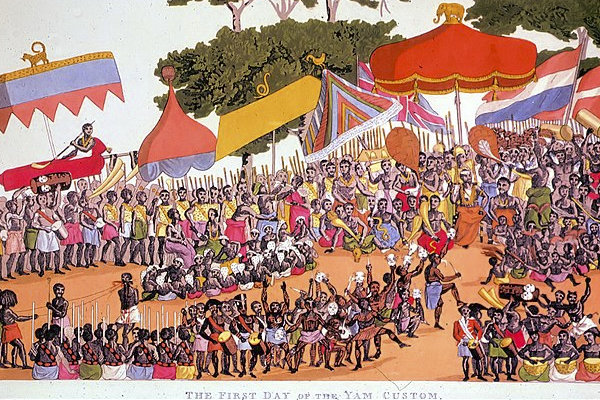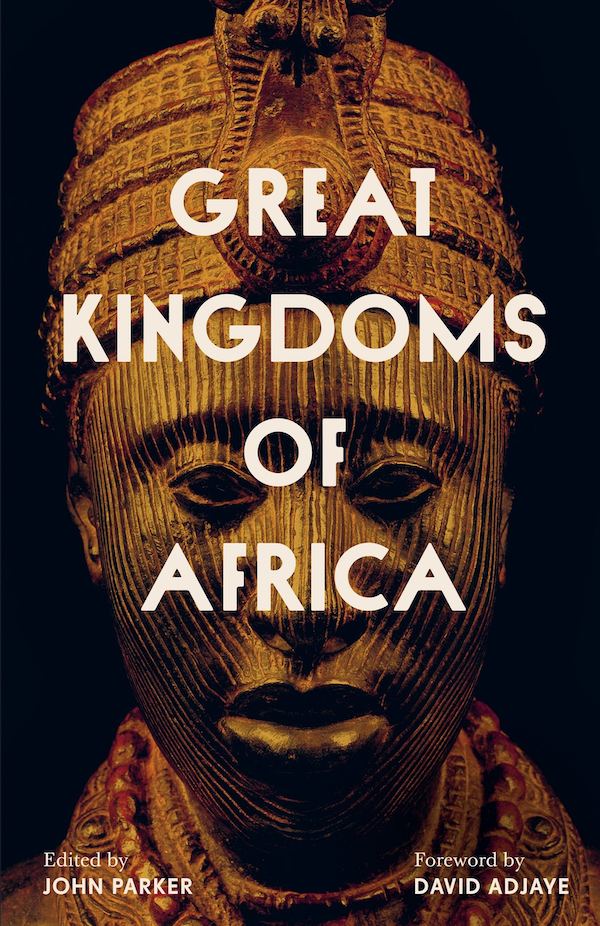Excerpt: The Akan Forest Kingdom of Asante

Asante Yam Ceremony, from Thomas Edward Bowdich"Mission from Cape Coast Castle to Ashantee" (London, 1819)
On 19 May 1817, Asantehene Osei Tutu Kwame welcomed for the first time a British diplomatic mission to his capital, Kumasi. The envoys and their African retinue had set out four weeks earlier from Cape Coast Castle, a fortified outpost on the seashore of the Gulf of Guinea, which from the mid-seventeenth century to 1807 had served as the headquarters of Britain’s slave-trading operations in West Africa. Making its way through the tropical forest up one of the eight ‘great roads’ radiating from Kumasi to the outer reaches of Asante’s imperial domains, the mission was instructed to halt at a town 30 miles (48 km) short of the capital while Osei Tutu Kwame presided over what it understood to be ‘the King’s fetish week’. This was the six-day period leading up to akwasidae, one of the two solemn adae ceremonies held in every forty-two-day cycle of the Asante calendar, during which the king withdrew from public gaze into the confines of his palace to commune with his ancestors and thereby ensure the well-being of the Asanteman, ‘the Asante nation’. Following an early-morning visit to the royal mausoleum containing the bones of his hallowed predecessors, he would then re-enter the public realm on what was deemed to be a particularly auspicious day for the conduct of diplomatic and other state business. It was on the afternoon of that day that the four British envoys were permitted to enter Kumasi. Emerging from the forest and the neat patchwork of agricultural settlements surrounding the capital, they were astounded by the spectacular choreographed display that enveloped them.
‘Upwards of 5000 people, the greater part warriors, met us with awful bursts of martial music, discordant only in its mixture; for horns, drums, rattles, and gong-gongs were all exerted with a zeal bordering on phrenzy, to subdue us by the first impression’, one of their number, T. Edward Bowdich, wrote (see pl. XVII). ‘The smoke which encircled us from the incessant discharges of musquetry, confined our glimpses to the foreground; and we were halted whilst the captains performed their Pyrrhic dance, in the centre of a circle formed by their warriors; where a confusion of flags, English, Dutch, and Danish, were waved and flourished in all directions.’ Inching their way through the thronging mass of dignitaries and townspeople, the party ‘passed through a very broad street, about a quarter of a mile long, to the market place’.
Our observations … had taught us to conceive a spectacle far exceeding our original expectations; but they had not prepared us for the extent and display of the scene which here burst upon us: an area of nearly a mile in circumference was crowded with magnificence and novelty. The king, his tributaries, and captains, were resplendent in the distance, surrounded by attendants of every description, fronted by a mass of warriors which seemed to make our approach impervious. The sun was reflected, with a glare scarcely more supportable than the heat, from the massy [i.e. solid] gold ornaments, which glistened in every direction. More than a hundred bands burst at once on our arrival, with the peculiar airs of the several chiefs ….
At least a hundred large umbrellas, or canopies, which could shelter thirty persons, were sprung up and down by the bearers with brilliant effect, being made of scarlet, yellow, and the most shewy cloths and silks, and crowned on the top with crescents, pelicans, elephants, barrels, and arms and swords of gold ….
The prolonged flourishes of the horns, a deafening tumult of drums … announced that we approached the king: we were already passing the principal officers of his household; the chamberlain, the gold horn blower, the captain of the messengers, the captain for royal executions, the captain of the market, the keeper of the royal burial ground, and the master of the bands, sat surrounded by a retinue and splendor which bespoke the dignity and importance of their offices.
Finally, Bowdich and his companions made their way into the pres- ence of the waiting Asantehene.
His deportment first excited my attention; native dignity in princes we are pleased to call barbarous was a curious spectacle: his manners were majestic, yet courteous … he wore a fillet of aggry beads round his temples, a necklace of gold cockspur shells … his bracelets were the richest mixtures of beads and gold, and his fingers covered in rings; his cloth was of a dark green silk … and his ancle strings of gold ornaments of the most delicate workmanship … he wore a pair of gold castanets on his fingers and thumb, which he clapped to enforce silence. The belts of the guards behind his chair, were cased in gold, and covered with small jaw bones of the same metal; the elephants tails, waving like a small cloud before him, were spangled with gold, and large plumes of feathers were flourished amid them. His eunuch presided over these attendants … [and] the royal stool, entirely cased in gold, was displayed under a splendid umbrella ….
The description goes on. As day turned to night, the vast reception continued by torchlight ‘and it was long before we were at liberty to retire’. Bowdich estimated the total number of warriors alone in attendance at thirty thousand.
The British effort to secure a treaty governing commercial and political relations with Asante failed. For the remainder of the nine- teenth century the two powers would be drawn into a series of recurring confrontations, until in 1896 the kingdom was occupied by the British, at the height of the European conquest and partition of Africa. Five years later, in the aftermath of a final, futile war of resistance, it was annexed to the older Gold Coast Colony. In 1957, the Gold Coast – with the Asante kingdom at its centre – became the independent nation of Ghana. The 1817 mission may have come to nothing, but Bowdich’s account, published two years later as Mission from Cape Coast Castle to Ashantee, represented the start of an enduring fascination with the great forest kingdom on the part of outside observers. Founded in the late seventeenth century, Asante would become the most powerful and prominent of what a recent study has called ‘fiscal-military states’ in West Africa. The rise of Oyo, Asante, Dahomey and Segu represented a new phase of militarized state-building after the fall of the Songhay Empire in 1591, and the expansion of the Atlantic slave trade marked the end of the ‘medieval’ period and the opening of an increasingly volatile ‘modern’ era in West Africa’s history. Asante was renowned for its fabulous wealth, and Bowdich leaves no doubt as to what that wealth was based on: gold. Heir to the tradition of West African gold production, which in the medieval period had supplied the precious metal to the trans-Saharan trade and from the fifteenth century had drawn acquisitive Europeans to the Atlantic coast, Asante entered world history as an alluring kingdom of gold. By the reign of Osei Tutu Kwame (r. 1804– 1823), it was at its peak in terms of wealth, military prowess and imperial reach. The nature of the kingship that emerged from and presided over this wealth in gold is the subject of this chapter.
The extracts quoted above from the description of the entry of the 1817 mission into Kumasi contain important clues to the nature of Asante statecraft. Kingship was based on the accumulation of wealth derived from forest agriculture and gold production, and was reinforced by military prowess and an elaborate and sophisticated government apparatus. It was also enshrined by spiritual power. As Bowdich observed, the Asantehene devoted a large amount of time and effort attending to the spiritual realm: for a start, for twelve days of every forty-two-day adaduanan or monthly cycle he was sequestered within his palace in the company of his departed ancestors. He also presided over a host of other ritual observations, performances and sacrifices, including the great Odwira festival, which served on an annual basis to recapitulate the historic project of Asante kingship. To what extent can Asante be seen to conform to the model of ‘sacred’ kingship as set out by the historical anthropologists David Graeber and Marshall Sahlins in their recent book, On Kings? This question lurks behind much debate among historians of Asante. Pioneering research tended to emphasize Asante’s material base, the complex structures of its office-holding elite and the bureaucratization of its government. Subsequent studies have been critical of this approach, exploring instead the ways in which political power was entangled with the spiritual realm and how the state sought to assert control over belief and knowledge in society. One thing is clear: while Asante at its height possessed formidable coercive or ‘instrumental’ power, it also possessed a dazzling array of ideological or ‘creative’ powers and the ability to project them. Its dynastic rulers were masterful performers of power.

Excerpted from Great Kingdoms of Africa by John Parker, published by the University of California Press. © 2023.